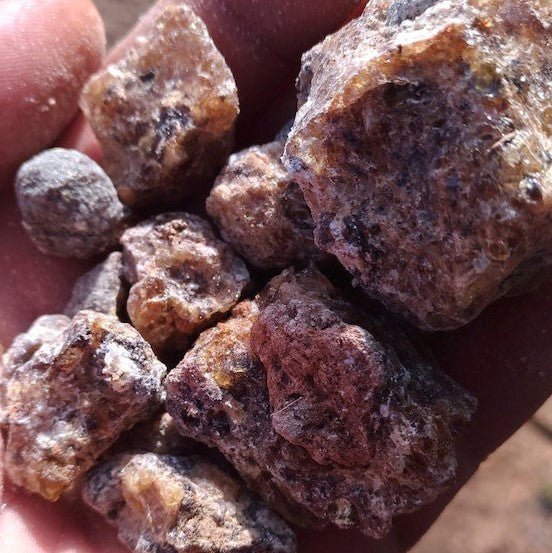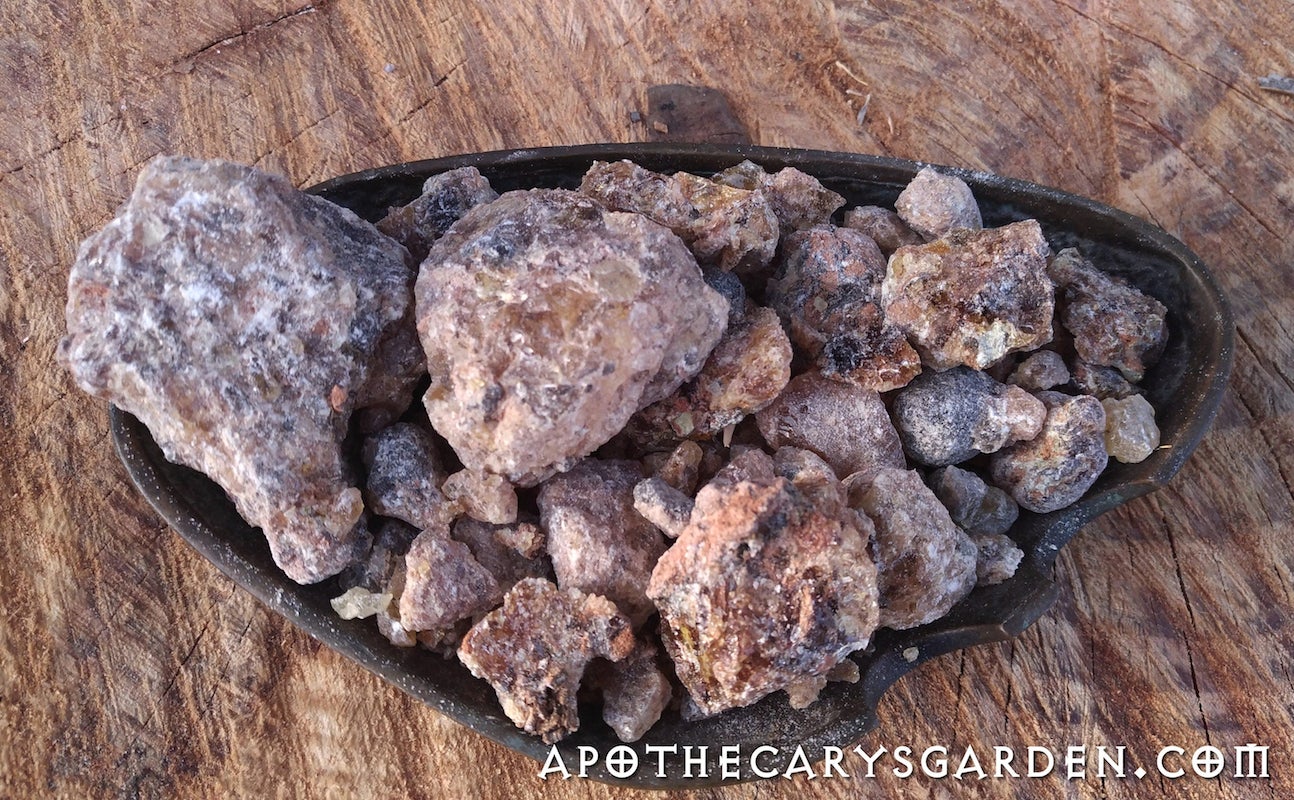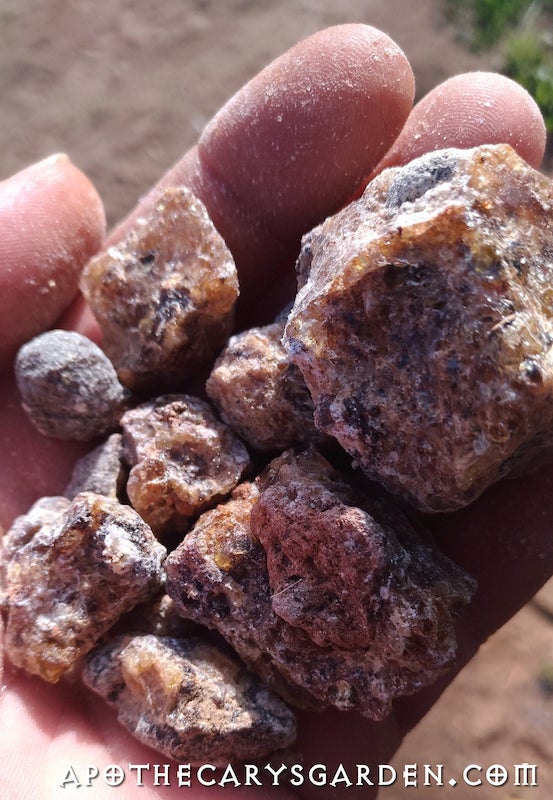


Frankincense Neglecta-Thurimel
Frankincense Neglecta Thurimel Resin- Somalia, Co-op harvested. "Frankincense Neglecta Light".
This is a type of aromatic resin that is not often seen in commerce.
The classic types of Frankincense appear in the form of tears.
The crystalline "Thurimels" or Honey type resins are traded locally and are traditionally used in ritual and medicine among the African harvester communities.
Diversifying the trade in resins gives harvesters and their communities a broader income base and a safety net in case the mainstream Frankincense and myrrh trees cannot be saved from their current decline. They are dying off worldwide at an alarming rate from both environmental stresses and human folly.
Often, up to 95% of their yearly income is generated from the collection and sale of these aromatic resins.
Olibanum & Thurimel
Our familiar Frankincense types are oleo-gum-resins and contain varying proportions of water-soluble gum. This combination of gum and oleoresin exudes from the tree as a white emulsion, giving Frankincense its traditional names- Luban in Arabic and Levonah in Hebrew, both based on the Semitic root word "White", לבן. The latin name for Frankincense, Olibanum and Oleum Liban in ancient Greek are both derivatives of this word. After thousands of years, we associate all Frankincense species with this white exudate.
Surprisingly, Boswellia neglecta is an oleoresin with no water-soluble gum. It appears as clear golden droplets and thus, is not an Olibanum or Luban.
Not only does this "Light" B. neglecta differ from other Frankincense resins in colour and composition, but the honey-coloured "Light" resin contrasts radically with the granular aromatic black resin produced alongside it on the very same tree which is commonly sold as Boswellia neglecta resin. Confused yet?
For these reasons, I felt we needed a good name for the amber resin of Boswellia neglecta. It sounded grammatically grating and irritatingly unimaginative to call it "Neglecta Light" in the shop.
So, for clarity, linguistic aesthetics, and to more easily differentiate the "light from the dark, I have dubbed the resin formerly known as Boswellia neglecta "Light"- Boswellia neglecta Thurimel. "Thurimel" means Frankincense Honey in Latin. I considered the other Latin version, Tus melle, but that sounded too smelly.
The scent of this Frankincense neglecta Thurimel from Somalia is more intense than the Kenyan variety. Though both share the same Amber Frankincense heart couched in sweet honey and soft musk, this variety is more vivid, fruity and citrusy than the Samburu Frankincense neglecta Thurimel. Other than the scent, and a slightly darker colour, it seems identical to the Kenyan variety in all ways. It is a pure oleoresin with no water-soluble gum which means it melts cleanly into the charcoal as incense, and just as readily, dissolves into warm oils and waxes for the production of moustache waxes, oils, salves and cremes. It makes a unique, essential oil which you will find in the shop . The infused oil of this Frankincense feel softening, nourishing and penetrating on the skin. I find it helps reduce feelings of anxiety and tightness of the chest.
An introduction to Boswellia Neglecta
The Boswellia or Frankincense neglecta resin of commerce is generally accepted as a dark, granular, blackish mass with a rich familiar Frankincense fragrance and a note of sweet Fir trees. l was convinced no tree could produce 2 resins so different in appearance. If I hadn't seen it with my own eyes in Northern Kenya I would still be sceptical.
The initial injury to the tree generates a clear oleoresin which hardens translucent and light golden. Subsequently, the tree creates traumatic resin ducts as do our Northern Spruce and Pines. These ducts generate a therapeutic compound called "Callus Resin" that acts as a bandage and promotes the growth of protective tissue that heals the wounds, creates "scar tissue," and isolates healthy tissue from diseased. I assume, that the presence of different chemical compounds lends a different fragrance profile to each of these oleoresins.
In Scandinavia, Spruce callus resin is used in traditional salves for slow-healing wounds and diabetic ulcers. This is the type of Boswellia neglecta resin we are familiar with in the West. It is granular, fragrant, and often tar-like in texture and colour.
I prepare my Frankincense "Heartsease oil" from the dark neglecta used in massage to help reduce anxiety, panic, and chest tightness.
In Northern Kenya, the Samburu women pick it off the trees in small tears which melt together in the 30-40 degree heat that accompanies most days in the bush. It is usually purchased as an aggregate in hardened lumps shaped by the women's hands as they keep the light resin separate from the dark.
As all its brothers, Frankincense Neglecta is ruled by the Sun from an astrological point of view. It is calming and strengthens both mind and heart, aids in meditation and concentration, and is thought to act as an aphrodisiac. It is assumed this oleoresin is composed of Boswellic (resin) acids, but I have yet to come across an analysis of the resin. It can be easily crushed and added to other materials when making incense blends and has a sweet, crisp, uplifting Amber fragrance.
Materials: Natural frankincense oleo resin, Frankincense Neglecta, Boswellia Neglecta, Frankincense neglecta Thurimel.





